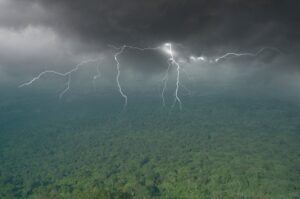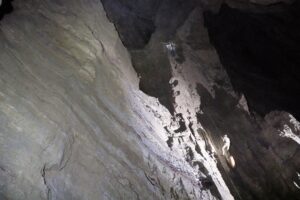Flourishing in harsh desert climates, dragon trees have long been steeped in myth. Indian, Arabian, and Greek cultures believed this tree, with its umbrella-shaped crown and spiny leaves, bled the blood of dragons. Since antiquity, people have sought the sap for its supposed medicinal and magical properties.
History
Many ancient sources reported on dragon’s blood trees, from Herodotus and Pliny to Marco Polo and Hindu texts.
In Hindu myth, the gods Brahma and Shiva fought in the form of a dragon and elephant respectively. The dragon bit the elephant and drank its blood. However, upon falling, the elephant crushed the dragon, and their blood mixed to form the tree’s red sap.
In Arabic culture, the dragon tree sprouted where brothers Darsa and Samha killed each other.

A dragon’s blood tree in an arid environment. Photo: Ann Stryzhekin/Shutterstock
In Greek mythology, the dragon’s blood tree myth comes from the legend of Heracles and Ladon. Ladon was a 100-headed dragon that guarded golden apples in the Garden of Hesperides. Heracles’s 11th labor was to steal the golden apples and kill Ladon. The spilled dragon’s blood led to the creation of the trees, and when cut, the tree bleeds Ladon’s blood.
Perhaps because of these legends, many people believed that the dragon’s blood trees held magical sap that could cure almost anything. The sap was also used as a component in the production of violins, artwork, home decor, pottery, cosmetic dyes, medicine, and brightly illustrated manuscripts. People have used their long leaves for rope. Some sources suggest that the Egyptians and Guanches of the Canary Islands used the dragon’s blood in embalming and mummification processes.
According to Mark Milburn, an expedition to Socotra Island by Oxford University researchers found “large artificial reservoirs, megaliths, temples, caves containing rock paintings, and glassware fused with dragon’s blood.”
Biology
There are 120 species of dracaena (dragon trees). Perhaps of the most famous species is the dracaena cinnabar, the dragon’s blood tree, which resembles a thick umbrella. You can find it high in the mountains on Socotra Island in Yemen, as well as on the Canary Islands, Cape Verde Islands, Madeira, Australia, parts of Asia, and North Africa.

The tree’s red sap. Photo: Adriana Lacob/Shutterstock
The tree grows rather slowly, usually taking a decade to mature and rarely passing 10m in height. However, the largest dragon’s blood tree ever recorded was the “Monster of Orotava” in Tenerife which grew to 20m. Unfortunately, a ferocious storm destroyed the beautiful tree in the 19th century. Yet this does not mean that this species is not resilient, it is exceptionally adaptive in extreme hot and cold conditions.
When cut, the tree’s blood-like sap crystallizes into hard bulbs on the surface of the trunk. Ancient peoples used to take this crystal and grind it into a powder or mix it with water.
The species’ growth pattern consists of two branches from which an additional two branches grow. It continues this way until a full crown develops and eaves and flowers grow every ten years.
Usually, when the tree matures, the leaves emerge from the youngest branches, according to the San Diego Zoo. While scientists can determine some tree’s age by analyzing its rings, they cannot determine a dragon tree’s age this way. Though it has no rings, scientists believe you can determine its age by counting the branches. Every two branches could equal 10 years, suggesting some dragon trees could be 1,000 years old.

Dragon’s blood resin. Photo: Spline_x/Shutterstock
The dragon tree’s role in the ecosystem is an important one. The trees provide much-needed shelter and shade for wildlife in arid environments. Because of its umbrella shape, the tree collects surrounding moisture and stores it in its trunk. It then releases the water into the soil, benefitting other plant species. According to The Guardian, the tree effectively encourages other species to grow near it.
Threats
Changes in climate, such as excessive rainfall and flooding have caused several trees in Socotra to die. Meanwhile, overgrazing and logging activities have decreased the dragon’s blood tree population significantly.
While there have been some efforts to replant the trees, the slow maturation process makes this a last resort.






